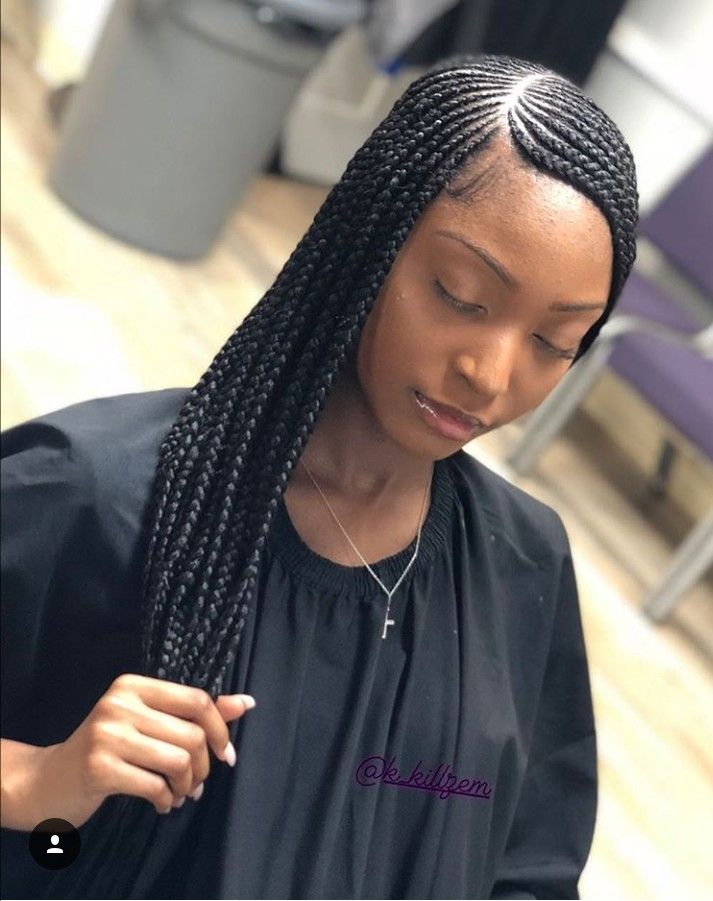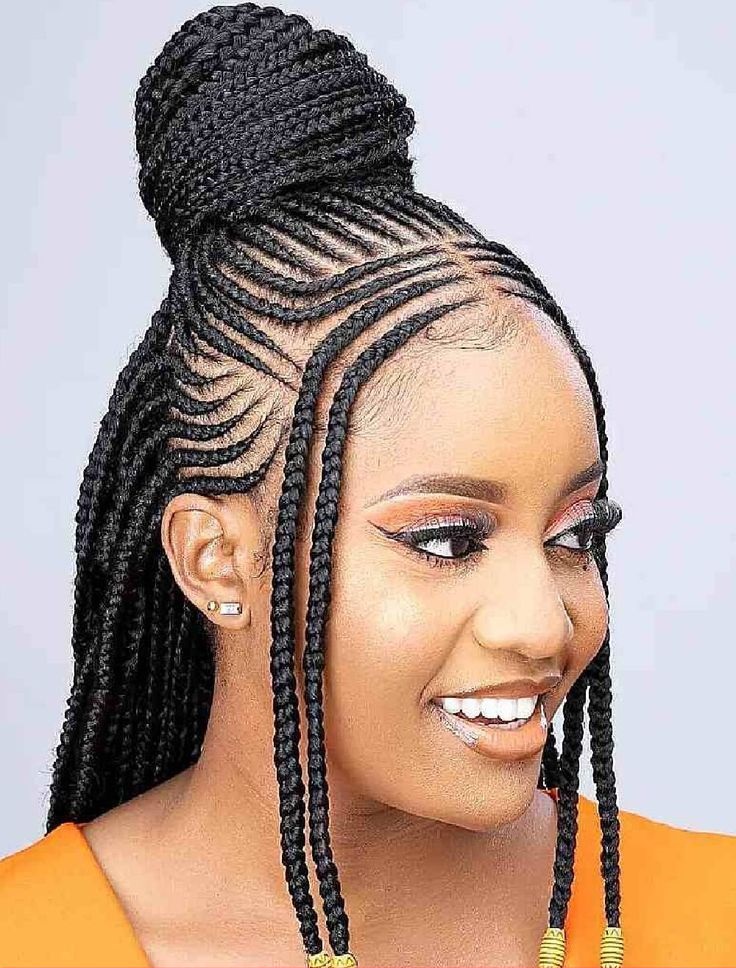African hair braiding styles can serve as a reliable go-to for effortless, heat-free summer styling, but don’t limit them to beach days alone. In fact, they can seamlessly transition into your fall hair routine, accommodating varying hair lengths and textures. Additionally, some of these styles can be done from the comfort of your own home without requiring a trip to the braiding salon. However, remember that proper natural hair care is crucial both before and after installing braids and twists. Explore 12 African hairstyles to experiment with this fall, and learn about the most effective ways to maintain your hair’s health while flaunting these attractive protective styles.

Popular African Braided Hairstyles
Throughout the summer, extra-long braids have remained a popular choice, with individuals opting for waist-length box braids and twists. Despite this trend, there is room for customization, as braid size, feed-in technique, and hair texture vary. To ensure easier twisting, it is recommended to begin any braided hairstyle with roughly blown-out hair. Prior to this, use Pracaxi Nectar Straight Blow Dry Cream to prevent heat damage. Once smoothed out, try out one of these sought-after styles.
- Goddess Braids: An eye-catching natural hair braided style that has been gaining popularity lately is the goddess braid. This look involves combining cornrows of different sizes into intricate patterns, creating an artful appearance. Thin braids are typically used to replace traditional parts, with chunky braids adjacent to them.

- Triangle Box Braids: Elevate your box braid game with Triangle Box Braids. Instead of the classic square parts, this style uses triangle shapes to give it a unique twist. For an even bolder look, opt for super-chunky Triangle Box Braids.

- Fulani Braids: Fulani Braids offer a hybrid of cornrows and box braids. The style starts with cornrows at the scalp and then transitions into free-flowing box braids with narrow parts in between.

- Lemonade Braids: Lemonade Braids take inspiration from Fulani Braids but with a side-swept twist. This style features long cornrows that fall on one side of the head, drawing attention to your facial features.

- Spiraled Ends: Create texture and dimension with Spiraled Ends. This style is a classic box braid with a twist – the ends are left undone for added texture. Use hair that curls or has a kinkier finish to really make the difference in texture stand out.

- Passion twists: Passion twists, a style that combines traditional box braids with looser, bubbly two-strand twists, have gained popularity in recent years. To achieve this look, start by parting your hair and moisturizing it with a leave-in cream before applying a light-hold gel. Secure each section with a rubber band and twist the loose ends of your hair before adding curly textured braid hair with a crochet needle. Twist your natural hair together with the extensions and pull sections to create little bubbles down the braid.

- Knotless braids: For a more natural look at the root and less tension on fragile edges, try knotless braids. This style involves weaving braiding hair into your own hair as you braid in a flat formation, either continuing into cornrows or coming off your head similar to Fulani braids. Unlike some box braid installations that create a knotted effect with extension hair around the strands at the root, knotless braids put less pressure on your scalp, protecting it from breakage.

- The Ponytail with Braids: To achieve the braided ponytail style, your hair is cornrowed until the crown of your head, and then tied into a ponytail. Each braid then cascades from the ponytail, creating a chic and stylish look. You can experiment with different braid sizes for added texture.

- Elaborate Halo Braid: The African halo braid is different from the typical halo braid as it features thin cornrows braided at the center of your head. You can choose to braid them straight or with intricate patterns. The crown is braided outward, while the central braids are woven into a chunky braid that encircles your head.

- Wavy Snake Braids: Snake braids are created by twisting cornrows in a wave-like pattern. These can be either chunky or slim, depending on your preference.

- Braided Chin-Length Bob: If you prefer shorter hair, you can opt for a braided bob. This style is achieved the same way as traditional box braids, except the braids are cut to chin length. The ends are smoothed to create a clean and classic blunt bob.

How Long Do African Hair Braiding Styles Last?
The duration that African hair braiding styles last depends on various factors such as the type of braids, the method used to create them, and the care given to the braids. On average, African hair braiding styles can last from two to eight weeks, although some styles can stay up to twelve weeks or even longer.
For example, braids made using synthetic hair extensions may last longer than those made with natural hair. The size and thickness of the braids can also affect how long they last, with thinner braids tending to last longer than thicker ones. Additionally, the way in which the braids are installed can affect their longevity. Tight braids can cause tension on the scalp and lead to breakage, while loose braids may unravel more quickly.
The way you care for your braids also plays a crucial role in how long they last. Proper maintenance and regular upkeep can extend the life of the braids. Some tips to care for your braids include keeping them clean, moisturized, and protected from environmental elements such as wind, sun, and water.
Ultimately, the duration that African hair braiding styles last varies from person to person and can depend on various factors. If you are unsure of how long your braids will last, it is best to consult with your stylist or do some research on the specific type of braids you are interested in.
Here’s a quick guide to help get the most out of your braids.
- Moisturize regularly: Braids can dry out your hair and scalp, so it’s important to moisturize regularly. Use a light oil like coconut or olive oil to keep your hair and scalp hydrated.
- Protect your edges: Braids can put a lot of tension on your edges, which can lead to hair loss. Protect your edges by applying a thin layer of edge control or gel and wrapping them in a satin scarf at night.
- Avoid excessive tension: Braids should be tight enough to stay in place, but not so tight that they cause pain or discomfort. Be sure to communicate with your braider about the level of tension you can handle.
- Keep your scalp clean: Dirt and buildup can accumulate on your scalp while wearing braids, leading to dandruff and itching. Use a scalp cleanser or witch hazel to keep your scalp clean and healthy.
- Give your hair a break: It’s important to give your hair a break between braiding styles to allow your hair to breathe and recover. Consider wearing a protective style like twists or a wig for a few weeks to give your hair a break.

Can I Do My Own African Braids?
However, be ready to allocate a few hours for the installation process. You can find numerous online tutorials that guide you through every step of the installation for the particular style you want to achieve. A piece of advice: If you’re not proficient in cornrowing your own hair, avoid the feed-in, knotless, and straight cornrow styles, and opt for crocheted braids and twists instead. This method doesn’t require braiding your own hair onto your scalp, and you don’t have to worry about it looking untidy or not entirely straight. You only need to attach extensions to secured sections of your natural hair. Keep in mind that whether you’re crocheting or cornrowing, sectioning can be time-consuming, particularly if you’re very meticulous about having precise parts.
Short Hair African Braided Hairstyles
African braids can be created with just a few inches of hair, and for shorter hair, it’s best to opt for feed-in styles to ensure a tight hold with the extension hair. While a skilled African hair braider can perform the classic knotted base technique, it may be challenging to do it yourself. If you have short hair, a braided updo that lets loose into curls is an excellent option, allowing for loose ends. To explore more hairstyle ideas and learn about proper care.

Guide to Protective Hairstyles for Natural Hair
- Braids: Braids are a popular protective style for natural hair. Box braids, cornrows, and Senegalese twists are just a few of the braid styles that can help protect your hair from breakage and damage. Be sure to moisturize your scalp and hair before braiding and avoid styles that are too tight.
- Twists: Two-strand twists are another protective style that can help keep your hair healthy. You can twist your hair in a variety of sizes and lengths, and you can even add extensions to create longer twists.
- Bantu knots: Bantu knots are a great protective style for natural hair that can create beautiful curls when taken down. Simply twist sections of hair and wrap them around themselves to create knots. Be sure to use a moisturizer or oil to keep your hair from drying out.
- Wigs: Wigs are a great protective style that can give you the versatility to switch up your look. Choose a wig that is made with natural hair to keep your hair healthy, and be sure to care for your natural hair underneath the wig.
- Updos: Updos are a simple and easy protective style that can help keep your hair out of your face and prevent breakage. Try a bun, a twist, or a braided updo to keep your hair protected.
Remember to take care of your hair while in protective styles. Moisturize regularly, avoid styles that are too tight, and don’t keep a style in for too long to prevent damage.
Read also: Get Creative with Your Hair: Learn How to Braid Your Own Hair
